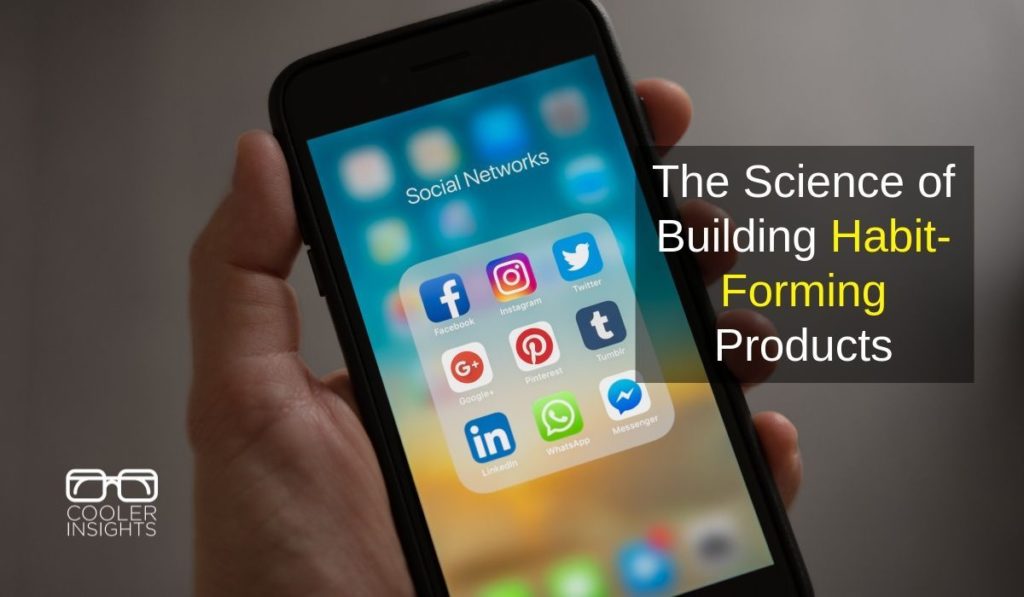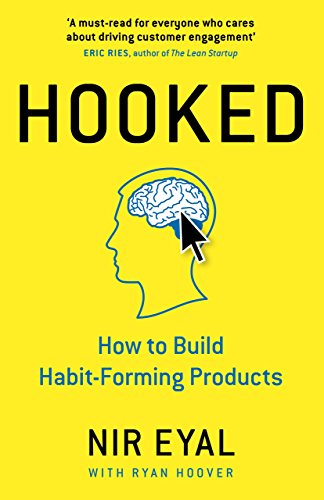
I walk a thin line in my role as a content marketer and media literacy advocate.
On one hand, I am excited about the possibilities which digital and social technologies can bring. On the flip side, I’m mindful of the dangers of digital addiction and how technologies can be used for nefarious purposes.
As I wrestled with my conflicting roles, I wondered how we can fuse technology and psychology to build products which foster positive habits.
That’s when this bright yellow book titled Hooked: How to Build Habit-Forming Products by Nir Eyal caught my eye.

Hooked proposes how ‘habit-forming’ products and services (most of them digital) are developed using a four-step process that “when embedded into products, subtle encourages customer behaviour.”
It seeks to answer these four questions:
- How do successful companies create products people can’t put down?
- Why do some products capture our attention while others flop?
- What makes us engage with certain things out of sheer habit?
- Is there an underlying pattern to how technologies hook us?
Let us look more closely at this model, and see how we can apply it in our businesses.
The Hook Model
Suggesting that habit-forming products often start as nice-to-haves (vitamins) but later become must-haves (painkillers), Eyal wrote that “designing habit-forming products is a form of manipulation.”
At its core, this process of “manipulation” is dependent on four critical steps:
- Trigger: The spark plug in the engine which can be both external and internal
- Action: The behaviour that your user performs in anticipation of a reward
- Variable Reward: The ability to create a craving and feedback loop, based on a variable reward
- Investment: The amount of work which the user puts into the actual product or service—time, data, effort, social capital or money
This can be visualised by the diagram below:

Courtesy of Nir Eyal
Through a constant process of iterative product development revolving around the four stages above, product designers can build products that are inherently habit-forming (and even addictive) in nature. This could then take on a shape of an infinity loop, much like the diagram below.

Courtesy of Nir Eyal
#1 Trigger—External and Internal
The first steps in building a habit-forming product lies in identifying suitable triggers. These cue the users to take action and come in two types—external and internal:
- External Triggers: These explicitly tell the users what to do next by placing information within the user’s environment. Think of the melodies, vibrations and visual notifications on WhatsApp, Facebook Messenger, and Twitter.
- Internal Triggers: These tell the user what to do next based on associations stored in the user’s memory. Frequently, negative emotions (eg Fear Of Missing Out or FOMO on Instagram) could serve as internal triggers.
To determine the right internal trigger, you should identify the specific frustration or pain point in emotional terms (rather than product features).
Use the 5 Whys method popularised by Toyota to ask deep probing questions of your user. Or you can use this narrative technique by filling in the blanks: “Every time the user ________ (internal trigger), he/she ________ (first action of intended habit).”
#2 Action
“Take a human desire, preferably one that has been around for a really long time… Identify that desire and use modern technology to take out steps.” – Evan Williams (co-founder of Blogger and Twitter)
The next stage involves driving your user to take specific actions—the simpler and less cumbersome these actions are, the better.
To make your task simple, consider Fogg’s Behaviour Model, where B = MAT. This represents that a given behaviour will occur when motivation, ability, and a trigger are present at the same time and in sufficient degrees.
a) Motivation
There are three core motivators driving our desire to act:
- To seek pleasure and avoid pain
- To seek hope and avoid fear
- To seek social acceptance and avoid rejection
b) Ability
Use Fogg’s six elements of simplicity to create simple to do actions for your product or service:
- Time: The shorter it takes to complete the action, the better
- Money: The cost of taking an action—less is more
- Physical Effort: Less labour equals to more action taken
- Brain Cycles: Keep the level of mental effort and focus to a minimum
- Social Deviance: The more socially accepted by others, the better
- Non-routine: The less the action matches existing routines, the better
Examples of easy to take actions include logging in with Facebook to a new app, sharing with Twitter or Facebook buttons, searching using Google, scrolling through a Pinterest feed, or taking photos on an iPhone with a simple flick on the home-screen.
#3 Variable Rewards
What draws us to act is not just the sensation we get from the reward itself, but our innate need to alleviate the craving for that reward.
This is where novelty comes into play. By breaking the cause-and-effect pattern, it sparks our interest and makes us pay attention again.
There are three types of variable rewards: the tribe, the hunt, and the self.
a) Rewards of the Tribe
Also known as social rewards, these are driven by our need to feel connected to other people.
Social networks like Facebook, Instagram, Twitter, Pinterest, YouTube, and LinkedIn are huge purveyors of social rewards—every like, reaction, tweet, pin, comment or share reflect a form of social validation.
b) Rewards of the Hunt
Citing how primitive humans are driven by the lure of hunting for big game, Eyal surmises that “the need to acquire physical objects, such as food and other supplies that aid our survival, is part of our brain’s operating system.”
In today’s world, these rewards of the hunt can be seen in casinos (awarding money in random intervals) and social media feeds providing random content ‘treasures’ that encourage scrolling behaviours.
c) Rewards of the Self
These more personal forms of gratification are fueled by “intrinsic motivation.” According to the self-determination theory of Edward Deci and Richard Ryan, people desire to gain a sense of competency—adding an element of mystery to this goal makes the pursuit all the more enticing.
Examples include:
- Video Games: Crossing different levels and gaining advanced weapons, visit uncharted lands, and improving a character’s skills and experience scores
- Email: Getting new emails from others
- FitBit: Accomplishing a certain number of steps (10,000) each day
In designing variable rewards, it is important to satisfy your users’ needs yet leave them wanting to reengage with the product. Hence, you should provide infinite variability by connecting them with others.
#4 Investment
Labour leads to love. The more your users invest time and effort into your product or service, the more they will value it.
They are also likely to be consistent with their past behaviours, and seek to adjust their preferences to avoid cognitive dissonance—the phenomena of having two conflicting ideas.
Here in the investment phase, your goal is to get your users to “do a bit of work.” By nudging them to put something into the system (eg updating their profiles or adding friends), it increases the likelihood of them using the product.
This process of storing value in the system can come in the form of content, data, increasing followers, improving reputation (eg in forums), or strengthening skill (eg games).
Finally, this investment of effort must result in loading the next trigger. Habit-forming technologies should leverage your user’s past behaviours to initiate an external trigger in the future.
Habit Testing Your Product
Once you’ve acquainted yourself with the Hook Model, it is useful to adopt the process of habit testing to refine your habit-building product development process. There are three steps you should take here:
1) Identify
Who are your product’s habitual users? How often should they be using your product?
The frequency of use should preferably be as realistic as possible, and not overly aggressive.
2) Codify
Once you’ve identified your habitual users, estimate how many of them would be sufficient to sustain your business. Eyal proposes 5 percent as a rule of thumb.
Study how these users interact with your product. Sift through your data to see if you can look for a Habit Path—a series of similar actions shared by your most loyal users.
3) Modify
Last, but not least, revisit your product and see how you can prompt new users down the same Habit Path.
This may include an update to your registration funnel, content changes, removal or addition or features, or emphasizing current features. Twitter used the insights gained from the ‘Codify’ process to change its onboarding process, encouraging new users to immediately begin following other users.
Conclusion
Building habit-forming products can turn an otherwise run-of-the-mill technology product into the next Uber, Amazon or Facebook.
To find opportunities and gain insights into habits that you can tap, the author suggests four ways to do so:
- Study your own behaviours
- Identify areas where a new technology makes cycling through the Hook Model faster, more frequent or more rewarding
- Look for nascent behaviours—new behaviours that innovators practice which can fulfill a mass-market need in the future
- Explore the potential of new technology and user interfaces
A wonderful and insightful read delving into the world of user-focused product development, Hooked is a must-read for anybody keen to learn more about building habit-forming technology based products.
I’m certainly going to apply its principles to help my clients build beneficial habit-forming products and services. What about you?

Thank you for sharing the informative and valuable information.
Hi By Walter, Informative blog post, and thanks for sharing this article!